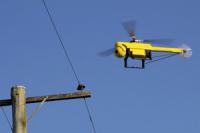-
Drones learn to navigate autonomously by imitating cars, bicycles

Researchers have developed an algorithm called DroNet which allows drones to fly completely by themselves through the streets of a city and in indoor environments. The algorithm had to learn traffic rules and adapt training examples from cyclists and car drivers.
-
-
Discrepancies between satellite and global model estimates of land water storage
Researchers have found that calculations of water storage in many river basins from commonly used global computer models differ markedly from independent storage estimates from GRACE satellites. The findings raise questions about global models that have been used in recent years to help assess water resources and potentially influence management decisions.
-
-
Climate engineering, if started, would have severe consequences if stopped abruptly
Facing a climate crisis, we may someday spray sulfur dioxide into the upper atmosphere to form a cloud that cools the Earth, but suddenly stopping the spraying would have a severe global impact on animals and plants, according to the first study on the potential biological impacts of geoengineering, or climate intervention. “Rapid warming after stopping geoengineering would be a huge threat to the natural environment and biodiversity,” says one expert. “If geoengineering ever stopped abruptly, it would be devastating, so you would have to be sure that it could be stopped gradually, and it is easy to think of scenarios that would prevent that. Imagine large droughts or floods around the world that could be blamed on geoengineering, and demands that it stop. Can we ever risk that?”
-
-
Climate change will displace millions in coming decades. Nations should prepare now to help them
By the middle of this century, experts estimate that climate change is likely to displace between 150 and 300 million people. If this group formed a country, it would be the fourth-largest in the world, with a population nearly as large as that of the United States. Yet neither individual countries nor the global community are completely prepared to support a whole new class of “climate migrants.” The scale of this challenge is unlike anything humanity has ever faced. By midcentury, climate change is likely to uproot far more people than the Second World War, which displaced some 60 million across Europe, or the Partition of India, which affected approximately 15 million. The migration crisis that has gripped Europe since 2015 has involved something over one million refugees and migrants. It is daunting to envision much larger flows of people, but that is why the global community should start doing so now.
-
-
Climate change will displace millions of people. Where will they go?

The 1951 Refugee Convention defines a protected refugee as someone who leaves his or her home country due to racial, religious, or social persecution, or reasonable fear of such persecution. These refugees have the right to seek asylum and protection from participating members of the United Nations (though these countries are not obligated to take them in). However, people displaced by climate change do not fit this definition. At the international level, there is no legal mechanism in place to protect climate migrants’ rights and to ensure assistance from other countries. For climate relocation to work, governments need to care and commit to international responsibility and burden-sharing. However, in the current global political context of fear of terrorism, an increased refugee influx into Europe, and an overall rise of xenophobia, countries are more likely to opt for stricter policies on cross-border migration.
-
-
Using fungi for self-healing concrete to fix bridges
America’s crumbling infrastructure has been a topic of ongoing discussion in political debates and campaign rallies. The problem of aging bridges and increasingly dangerous roads is one that has been well documented and there seems to be a consensus from both democrats and republicans that something must be done. Researchers propose using fungi for self-healing concrete — a low-cost, pollution-free, and sustainable approach to shoring up U.S. infrastructure.
-
-
Thorium reactors could dispose of large amounts of weapons-grade plutonium
Scientists are developing a technology enabling the construction of high-temperature, gas-cool, low-power reactors with thorium fuel. The scientists propose to burn weapons-grade plutonium in these units, converting it into power and thermal energy. Thermal energy generated at thorium reactors may be used in hydrogen industrial production. The technology also makes it possible to desalinate water.
-
-
Checking chemical detectors’ sensitivity to chemicals

The Joint Chemical Agent Detector (JCAD) has become an important defense tool on battlefields and in war-torn cities over the last few years. About the size and shape of a VHS tape or a hardcover bestselling novel, JCADs sound an alarm and begin to light up if nerve agents such as sarin or blister agents such as mustard gas are present. The detectors are already designed to withstand intense environments and repeated use. But when the Department of Defense wanted a way to check the devices’ sensitivity to chemicals over time, a measurement team at the National Institute of Standards and Technology (NIST) was called in to provide a cost-effective solution.
-
-
Interconnected technological risks: Responding to disruptions of cyber-physical systems
When infectious diseases strike, the World Health Organization acts swiftly, coordinating with the U.S. Centers for Disease Control and Prevention and its foreign counterparts to contain the threat. But there is no equivalent international organization similarly dedicated to identifying and mitigating a cyberattack. The World Economic Forum (WEF), however, is bringing together infrastructure and technology developers, insurers and government officials from across the globe to develop strategies for responding to interconnected technological risks, including those that can cascade when hackers disrupt cyber-physical systems.
-
-
Long-term warming trend continued in 2017: NASA, NOAA
Earth’s global surface temperatures in 2017 ranked as the second warmest since reliable instrumental records began in 1880, according to an analysis by NASA. Continuing the planet’s long-term warming trend, globally averaged temperatures in 2017 were 1.62 degrees Fahrenheit (0.90 degrees Celsius) warmer than the 1951 to 1980 mean. The planet’s average surface temperature has risen about 2 degrees Fahrenheit (a little more than 1 degree Celsius) during the last century or so, a change driven largely by increased carbon dioxide and other human-made emissions into the atmosphere. Last year was the third consecutive year in which global temperatures were more than 1.8 degrees Fahrenheit (1 degree Celsius) above late nineteenth-century levels.
-
-
2018: Critical period of intensified risks
The Global Risks Report 2018, published this week by the World Economic Forum cautions that we are struggling to keep up with the accelerating pace of change. It highlights numerous areas in which we are pushing systems to the brink, from extinction-level rates of biodiversity loss to mounting concerns about the possibility of new wars. The reports says that the structural and interconnected nature of risks in 2018 threatens the very system on which societies, economies, and international relations are based – but that the positive economic outlook gives leaders the opportunity to tackle systemic fragility.
-
-
Distant-scanning crowds for potential threats
Everyone wants to be safe and secure, but can you imagine if you had to go through a security screening at the metro station like there is at the airport? What if there were a way to safely scan crowds for potential threat items in places like metro and train stations without security officials coming into direct contact with the public and while maintaining individual privacy?
-
-
Call for proposals on advanced first responder technologies
Applications are now being accepted for the NextGen First Responder Technologies solicitation, an opportunity for a maximum conditional grant of up to $1 million, jointly funded by the DHS S&T and the Israel Ministry of Public Security (MOPS). the NextGen First Responder Technologies program is looking for innovations in fields such as protective clothing, wearable technology and situational awareness.
-
-
U.K. gov. launches £3M competition for innovative airport bomb-detection tech
Two U.K. government ministries — the Home Office and Department for Transport—have launched a Dragons’ Den-style investment prize, hoping to find innovative ways to detect bombs in laptops, phones, and cameras carried by passengers on board. The government has announced a £3 million competition in an effort to attract scientists and inventors to help the security services and the airline industry keep up with the nefarious ingenuity of terrorists.
-
-
AI used to limit collision-prone roadways
Could a traffic agency identify a potentially dangerous road intersection without first witnessing a collision? Researchers are attempting to answer that question as they near completion on a two-year proof-of-concept study to develop an image-based system for monitoring and assessing the safety of intersections.
-
More headlines
The long view
The Future of Open Data in the Age of AI: Safeguarding Public Assets Amid Growing Private Sector Demands
AI offers immense potential, but that potential must be realized within a framework that protects the public’s right to its own information. The open data movement must evolve to meet this new challenge—not retreat from it.
Horses for Courses: Where Quantum Computing Is, and Isn’t, the Answer
By Stephan Robin
Despite the impressive and undeniable strides quantum computing has made in recent years, it’s important to remain cautious about sweeping claims regarding its transformative potential.
Federal R&D Funding Boosts Productivity for the Whole Economy − Making Big Cuts to Such Government Spending Unwise
By Andrew Fieldhouse
Large cuts to government-funded research and development can endanger American innovation – and the vital productivity gains it supports. If the government were to abandon its long-standing practice of investing in R&D, it would significantly slow the pace of U.S. innovation and economic growth.
Why Ukraine’s AI Drones Aren’t a Breakthrough Yet
By David Kirichenko
Machine vision, a form of AI, allows drones to identify and strike targets autonomously. The drones can’t be jammed, and they don’t need continuous monitoring by operators. Despite early hopes, the technology has not yet become a game-changing feature of Ukraine’s battlefield drones. But its time will come.
New Tech Will Make Our Airplanes Safer
By Yulia Karra
Odysight.ai’s technology allows for constant monitoring of aircraft, sending alerts in case of malfunctions that could lead to accidents.
New Technology is Keeping the Skies Safe
DHS S&T Baggage, Cargo, and People Screening (BCP) Program develops state-of-the-art screening solutions to help secure airspace, communities, and borders
